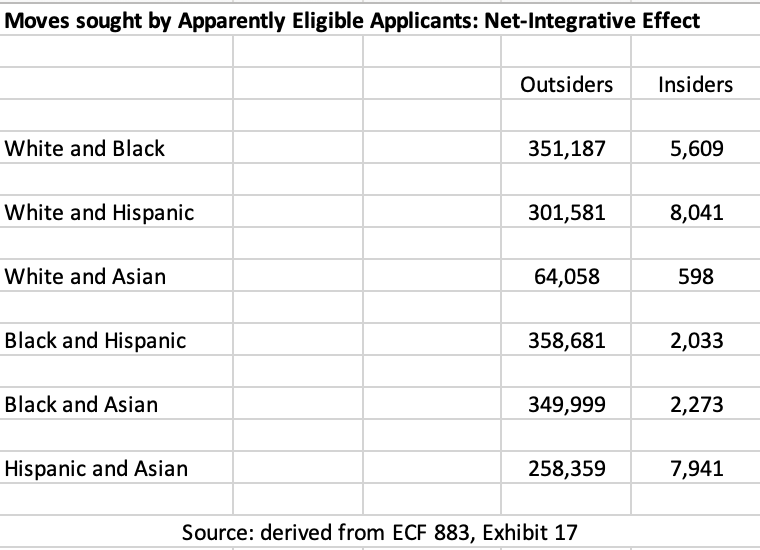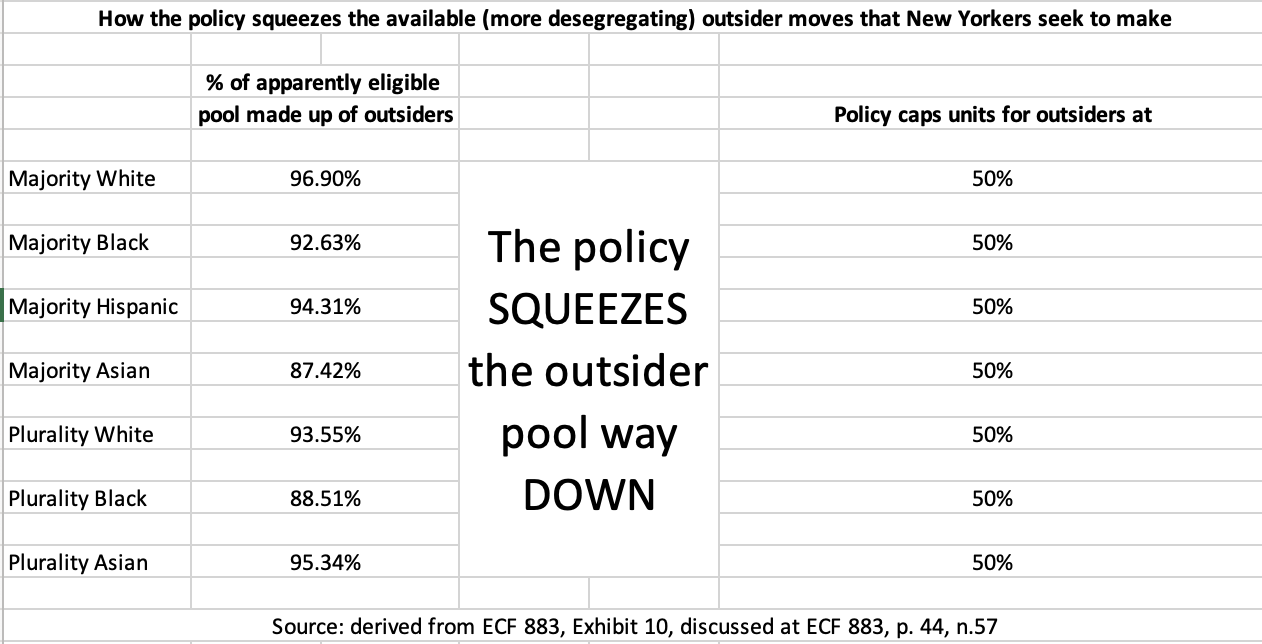NYC thwarted in bid to avoid trial in discrimination case challenging its outsider-restriction policy in affordable-housing lotteries
In a recent Opinion and Order, the Hon. Laura Taylor Swain, Chief Judge of the federal district court for the Southern District of New York, cleared the way for a trial to be held as to whether New York City’s outsider-restriction policy in its affordable housing lotteries violates the federal Fair Housing Act and the New York City Human Rights Law. There is no question that the policy racially discriminates in multiple ways:
(1) Perpetuation of segregation. A lottery starts out with a racially diverse citywide pool of applicants. The moves that the overwhelming number of apparently eligible applicants (those living outside the community district where the housing is located, referred to as “outsiders”) want to make are, on balance, substantially more desegregating than the moves that those living within the community district (“insiders”) want to make. But the City’s policy powerfully squeezes down the percentage of apartments available to outsiders, thus slowing down the racially integrating moves that would otherwise be made. Scroll down on this page to see more details of how this works.
(2) Racially disparate impacts. This means that the policy causes a New Yorker’s chances in lotteries to vary significantly by race (the applicant’s versus the dominant racial group in the community district in which the housing is located). The Court has already found that “…Plaintiffs have shown that multiple racial demographic groups are affected in multiple [community district] typologies…” The reference to typologies is to the racial typographies of different community districts (e.g., majority White). The widespread nature of these racially disparate results of the policy are discussed here, along with the City’s (thus far successful) defense that discrimination against a racial group in some areas of the city can be “offset” by discrimination in favor of that racial group in other parts of the city. Plaintiffs have moved the Court to reconsider the shocking idea that this new version of “separate but equal” could ever be consistent with our civil rights laws.
(3) Intentional racial discrimination. In this context, this means that the City has allowed itself to be influenced to exapnd and continue the policy by those who wish to maintain the segregated residential status quo. There is an unusually large amount of evidence supporting this claim. See more here.
The bottom line is that, in 2023, New York City should not be in the business of overriding the choices that New Yorkers of all races want to make on their own. All of our communities should belong to all of us — regardless of where we are coming from. and regardless of where we want to move. And the policy — denying, based on race, a level playing field — operates squarely against that basic civil rights principle.
Perpetuation of segregation
Without the policy, each New Yorker who applies to a lottery would be treated the same. But the policy divides New Yorker into “insiders” (those who live in the community district where the housing is being built) and “outsiders” (those New Yorkers who don’t). How does that splitting affect segregation?
When segregation is looked at, what is compared are two racial/ethnic groups at a time. The experts from both sides agreed on which moves had or would have an integrative effect, which moves had or would have a segregative effect.
When moves made or sought were tabulated, it was possible to see — separately for outsiders and insiders — what the net result of the integrating and segregating moves were.
This first chart below examines the moves that were sought by apparently eligible applicants. These show raw numbers. As you can see, the net-integrative effect for outsiders absolutely swamps the net-integrative effect for insiders in every case.

It is true that there are many more outsiders than insiders, so we also looked at the percentage of the moves sought by apparently eligible outsiders that were net-integrative and compared that to the percentage of the moves sought by apparently eligible insiders that were net-integrative. That way, we could see how much faster desegregation proceeds with outsiders than with insiders. So, for example, 30 percent net-integrative for outsider moves compared to 10 percent net-integrative for insider moves is, in relative terms, 300 percent higher. This next chart shows those relative percentages.

So what does the policy do with those moves that outsiders desire to make, moves that are much more desegregating by the choice of our fellow New Yorkers themselves? Well, it takes the enormous outsider pool — almost 97 percent of applicants for housing in majority White community districts — and dramatically squeezes down percentage of apartments available to those outsiders (outsiders, just as a reminder, mean New Yorkers outside of the community district who qualify for affordable housing and who have been found, overall, to be just as rent-burdened and extremely-rent-burdened as insiders). See chart below. This is a way that the City’s policy causes there to be more segregation than there would be in the absence of the policy.

>> We have always said that there is a simple solution: the City should take its thumb off the scale and honor the choices that New Yorkers are making via their applications — wherever they are coming from and wherever they wish to move.
